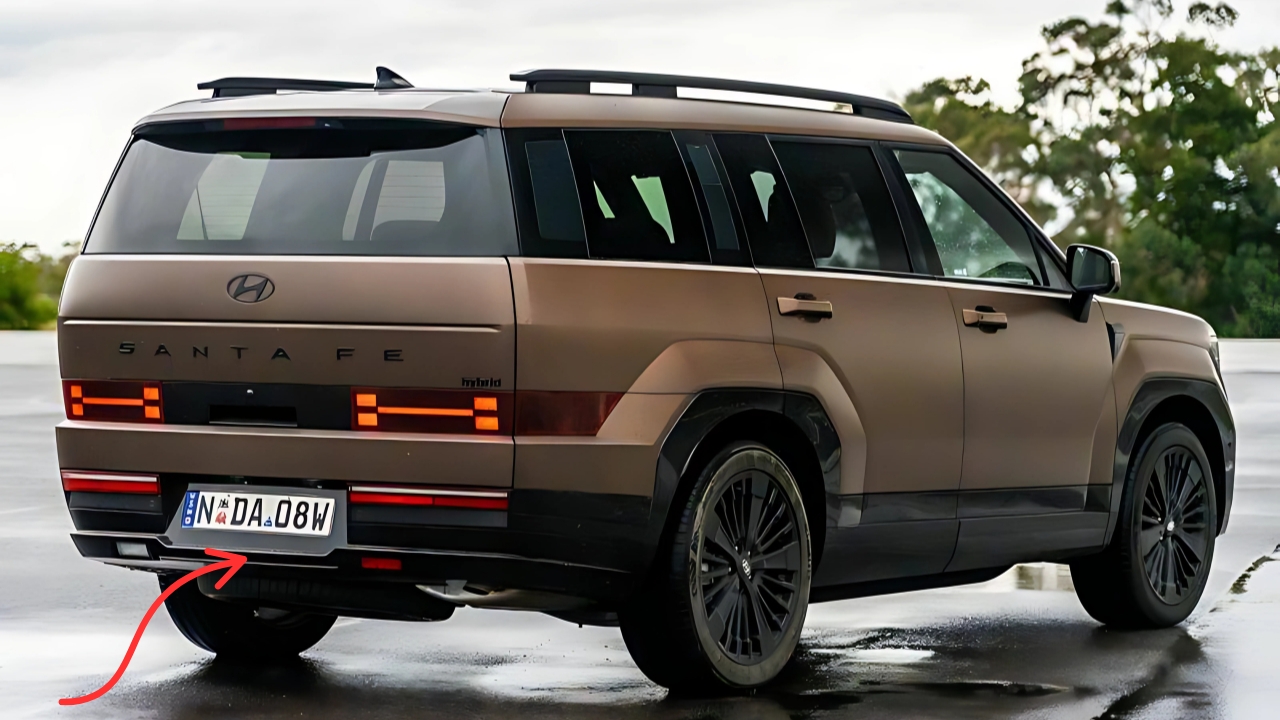Hyundai Santa Fe Hybrid : The automotive landscape continues its relentless march toward electrification, but that journey comes with evolving price tags that often catch consumers off guard.
Recently, Hyundai made headlines when they announced a significant price adjustment for their popular Santa Fe Hybrid lineup, implementing a $1500 increase across all hybrid variants for the 2025 model year.
This development has sent ripples through the SUV market, prompting questions about the future direction of hybrid vehicle pricing and what it means for families considering their next vehicle purchase.
When you first hear about a price increase of this magnitude, it’s natural to wonder what’s driving such a substantial change. The automotive industry has been navigating a complex web of challenges over the past few years, from supply chain disruptions to evolving consumer demands for more advanced technology and better fuel efficiency.
Understanding these market forces helps explain why manufacturers like Hyundai are making strategic pricing decisions that reflect the true value proposition of their hybrid offerings.
Understanding the 2025 Santa Fe Hybrid Price Adjustment
The $1500 price increase that took effect on May 1, 2025, represents more than just a simple cost adjustment. It signals Hyundai’s strategic repositioning of their hybrid technology as a premium offering worthy of its enhanced pricing structure.
Interestingly, this increase affects only the hybrid variants of the Santa Fe, while the traditional gasoline-powered models remain unchanged in their pricing structure.
This selective pricing strategy creates a new dynamic in the Santa Fe lineup, establishing a consistent $4000 gap between gasoline and hybrid variants, up from the previous $2500 difference.
This pricing realignment brings the Santa Fe Hybrid in line with similar gaps found across Hyundai’s other hybrid offerings, including the Tucson and Kona models, suggesting a broader company strategy rather than an isolated adjustment.
The timing of this price increase also tells an interesting story. The current-generation Santa Fe initially launched with only hybrid power in May 2024, with gasoline variants arriving later in December. Had Hyundai launched the hybrid at current pricing levels from the beginning, the initial sticker shock might have been even more pronounced, potentially impacting early adoption rates.
What Drives Hybrid Vehicle Pricing in Today’s Market
Understanding why hybrid vehicles command premium pricing requires examining the complex technology that makes them possible. The Santa Fe Hybrid employs a sophisticated turbocharged 1.6-liter four-cylinder engine paired with an electric motor, delivering a combined 231 horsepower while maintaining impressive fuel efficiency ratings. This dual-power system requires specialized components, advanced battery technology, and intricate engineering that naturally increases manufacturing costs.
Beyond the technical complexity, hybrid vehicles represent a significant investment in research and development that manufacturers must recoup through pricing strategies. The integration of electric motors, battery systems, and regenerative braking technology demands specialized manufacturing processes and quality control measures that don’t exist in traditional gasoline vehicle production.
Market demand also plays a crucial role in hybrid pricing dynamics. As consumers increasingly prioritize fuel efficiency and environmental consciousness, hybrid vehicles have transitioned from niche offerings to mainstream choices. This growing demand, combined with the inherent value proposition of reduced fuel costs over time, supports premium pricing structures that reflect the long-term benefits these vehicles provide.
The Santa Fe Hybrid’s Competitive Position
Despite the price increase, the Santa Fe Hybrid maintains a competitive position within the crowded mid-size SUV segment. Starting at approximately $38,615 for the base SEL trim, it continues to undercut several competitors including the Toyota Highlander Hybrid and maintains pricing parity with other strong contenders like the Kia Sorento Hybrid.
The Santa Fe Hybrid’s value proposition extends beyond just its hybrid powertrain. The vehicle offers standard three-row seating, a spacious cargo area, and a comprehensive suite of safety features that help justify its premium positioning. The dramatic styling overhaul that accompanied the latest generation has also helped distinguish the Santa Fe in showrooms, where visual appeal often drives initial consideration.
When evaluating the total cost of ownership, the Santa Fe Hybrid’s fuel efficiency ratings of 36 mpg city and 35 mpg highway can help offset the higher initial purchase price through reduced fuel expenses over time. For families who drive significant miles annually, these efficiency gains can translate into meaningful savings that help justify the hybrid premium.
Industry Trends Influencing Hybrid Pricing

The automotive industry is experiencing a fundamental shift in how manufacturers approach hybrid vehicle pricing and positioning. Rather than treating hybrids as experimental technology with modest price premiums, companies are increasingly positioning these vehicles as sophisticated alternatives that command pricing commensurate with their advanced capabilities.
This evolution reflects broader market maturation where hybrid technology has proven its reliability and consumer acceptance. Early hybrid adopters were often motivated primarily by environmental concerns and were willing to accept compromises in performance or features. Today’s hybrid buyers expect vehicles that deliver superior fuel efficiency without sacrificing the comfort, capability, and features they demand from their primary family vehicle.
Regulatory pressures also influence hybrid pricing strategies as manufacturers work to meet increasingly stringent fuel economy and emissions standards. The investment required to develop and produce vehicles that meet these evolving requirements must be balanced against consumer price sensitivity and competitive positioning within respective market segments.
Supply Chain Considerations and Manufacturing Costs
The global semiconductor shortage and other supply chain disruptions of recent years have highlighted the complexity of modern vehicle manufacturing, particularly for hybrid and electric vehicles that rely on sophisticated electronic components. These challenges have contributed to increased manufacturing costs that inevitably influence retail pricing decisions.
Battery technology, while improving rapidly in capability and efficiency, remains one of the most expensive components in hybrid vehicles. The specialized lithium-ion battery packs used in vehicles like the Santa Fe Hybrid require rare earth materials and complex manufacturing processes that contribute significantly to overall vehicle costs.
Additionally, the relatively lower production volumes of hybrid variants compared to traditional gasoline models mean that manufacturers cannot achieve the same economies of scale that help reduce costs for high-volume conventional vehicles. This economic reality necessitates pricing strategies that ensure profitability while maintaining market competitiveness.
Consumer Impact and Market Response
The $1500 price increase for the Santa Fe Hybrid presents both challenges and opportunities for potential buyers. For consumers who were already considering the hybrid variant, this increase may prompt more careful evaluation of the long-term value proposition, including fuel savings, potential tax incentives, and resale value considerations.
However, market data suggests that Santa Fe sales remain strong despite the price adjustment. Hyundai has sold 2141 Santa Fes in Australia this year through April, representing a 78.3 percent increase over the same period last year, though this growth partially reflects the transition from the previous generation model.
The pricing change also creates new dynamics in the competitive landscape, potentially making alternatives like the Kia Sorento Hybrid or Toyota Highlander Hybrid more attractive to price-sensitive buyers. Conversely, it may strengthen the position of non-hybrid variants for buyers who prioritize initial purchase price over long-term fuel efficiency.
Future Implications for Hybrid Vehicle Market
This pricing adjustment by Hyundai reflects broader industry trends that suggest hybrid vehicles will continue commanding premium pricing as manufacturers invest heavily in electrification technologies. Rather than viewing hybrids as transitional technology, companies are positioning them as sophisticated, long-term solutions that bridge the gap between traditional combustion engines and full electrification.
The success of this pricing strategy will likely influence how other manufacturers approach hybrid vehicle positioning and pricing in the coming years. If consumers continue to accept these premium pricing structures while recognizing the value proposition of hybrid technology, it could accelerate industry-wide adoption of similar strategies.
For potential buyers, this trend suggests that waiting for hybrid prices to decrease significantly may not be a viable strategy. Instead, focusing on the total cost of ownership and long-term value proposition becomes increasingly important when evaluating hybrid vehicle purchases.
Making Sense of the Value Proposition
Despite the price increase, the Santa Fe Hybrid continues to offer compelling value for families seeking a versatile, efficient SUV. The combination of three-row seating, advanced safety features, comprehensive warranty coverage, and impressive fuel efficiency creates a package that justifies its premium positioning for many buyers.
The vehicle’s 10-year/100,000-mile warranty coverage for both the powertrain and hybrid battery system provides additional peace of mind that helps offset concerns about the higher initial investment. This extensive warranty coverage demonstrates Hyundai’s confidence in their hybrid technology and provides tangible value that extends well beyond the purchase transaction.
For buyers evaluating the Santa Fe Hybrid against competitors, it’s important to consider not just the initial purchase price but the complete ownership experience, including fuel costs, maintenance requirements, warranty coverage, and expected resale value. When viewed through this comprehensive lens, the Santa Fe Hybrid’s value proposition remains strong despite the recent price adjustment.
Frequently Asked Questions
Why did Hyundai increase the Santa Fe Hybrid price by $1500? The price increase reflects Hyundai’s strategic positioning of hybrid technology as a premium offering and aligns the Santa Fe Hybrid pricing with their broader hybrid vehicle lineup strategy.
Does the price increase come with any new features or improvements? No, the $1500 price increase does not include any specification changes or new features for the 2025 model year Santa Fe Hybrid.
Are non-hybrid Santa Fe models affected by this price increase? No, the price increase affects only Santa Fe Hybrid variants, while traditional gasoline-powered Santa Fe models remain unchanged in pricing.

